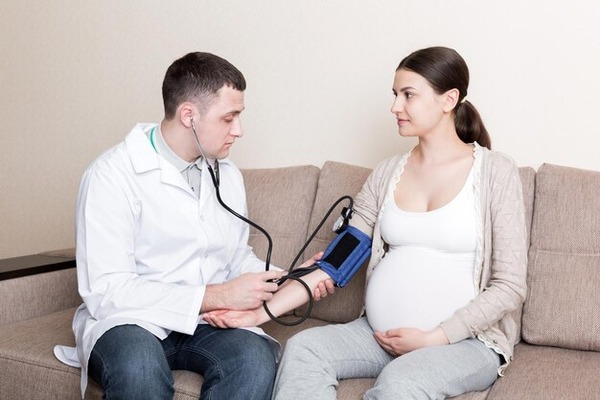
HOW HIGH BLOOD PRESSURE AFFECT PREGNANCY? A RISK FACTOR FOR PREECLAMPSIA.
What is High Blood Pressure?
Blood pressure refers to the pressure exerted by blood against the walls of arteries, which are the vessels responsible for transporting blood from the heart to various parts of the body. When the pressure within these arteries becomes elevated, it results in high blood pressure. This condition can impose additional strain on the heart and kidneys, potentially contributing to the development of heart disease, kidney disease, and stroke.
In the United States, healthcare professionals characterize high blood pressure (hypertension) as having a systolic blood pressure (the top number) of at least 130 mmHg and/or a diastolic blood pressure (the bottom number) of at least 80 mmHg.
What Is High Blood Pressure In Pregnancy?
A pregnant woman receives a diagnosis of hypertension when her blood pressure readings surpass 140 mmHg systolic or 90 mmHg diastolic on two distinct occasions, typically observed during her appointments with her Obstetrician/Gynecologist (OB/GYN) provider. If the reading reaches 160/110 mmHg or exceeds this threshold, the woman is diagnosed with severe high blood pressure.
High blood pressure during pregnancy is a serious medical condition that can have implications for both the mother and the baby. Several types of high blood pressure disorders that can occur during pregnancy are:
- Gestational Hypertension: This type of high blood pressure develops after 20 weeks of pregnancy. It usually resolves after childbirth.
- Preeclampsia: This is a more severe condition that includes high blood pressure and damage to organs such as the liver and kidneys. Preeclampsia can be life-threatening and may require early delivery of the baby.
- Chronic Hypertension: Some women have high blood pressure before becoming pregnant or develop it before 20 weeks of pregnancy. This is known as chronic hypertension.
- Chronic Hypertension with Superimposed Preeclampsia: Women with chronic hypertension may also develop preeclampsia during pregnancy, which can complicate the condition.
What Is Preeclampsia?
When elevated blood pressure manifests after 20 weeks of pregnancy, it is referred to as gestational hypertension. Preeclampsia is a severe condition associated with gestational hypertension, it is the detection of protein in the mother’s urine. Preeclampsia exerts strain on the heart and vital organs, potentially leading to severe complications such as compromised blood supply to the placenta, liver and kidney damage, or accumulation of fluid in the lungs. The presence of protein in the urine signals kidney dysfunction. Preeclampsia can manifest in varying degrees of severity, and even seemingly mild cases have the potential to rapidly progress to more serious complications.

What are the symptoms of high blood pressure or preeclampsia during pregnancy?
Numerous pregnant individuals with high blood pressure may not exhibit noticeable symptoms. Nevertheless, certain warning signs may accompany preeclampsia:
1. Painful headaches
2. Swelling in the feet, ankles, and legs
3. Swelling in the face or hands
3. Blurred vision
4. Temporary blindness
5. Sensitivity to light
6. Pain beneath the rib cage
Pregnant women with preeclampsia or eclampsia may encounter severe complications, including:
1. Seizures
2. Stroke
3. Coma
Who Are At The Risk Of Preeclampsia?
Several factors increase the risk of developing preeclampsia during pregnancy. These risk factors include:
- History of high blood pressure: Individuals with a pre-existing history of hypertension have an elevated risk of developing preeclampsia during pregnancy.
- Kidney disease or diabetes: Pre-existing kidney disease or diabetes can contribute to an increased risk of preeclampsia.
- Expecting multiples (twins, triplets, etc.): Women carrying multiple fetuses are at a higher risk of developing preeclampsia compared to those with a singleton pregnancy.
- Family history of preeclampsia: If there is a history of preeclampsia in the family, particularly among first-degree relatives, the risk of developing the condition may be higher.
- Autoimmune conditions like lupus: Individuals with autoimmune disorders, such as lupus, have an increased susceptibility to preeclampsia.
- Obesity: Being overweight or obese before pregnancy can elevate the risk of developing preeclampsia.
What Complications Can Be Caused By Preeclampsia?
Preeclampsia poses significant risks to both pregnant individuals and their developing babies, potentially resulting in complications such as:
- Placental abruption: Detachment of the placenta from the uterine wall.
- Fetal growth restriction: Slowed growth of the fetus due to reduced nutrient supply through the umbilical cord.
- Oligohydramnios: Decreased levels of amniotic fluid surrounding the baby in utero.
- Preterm delivery: Delivering before 37 weeks to prevent severe complications for both the pregnant person and/or the fetus.
- Kidney or liver damage: Preeclampsia can adversely affect the functioning of the kidneys and liver.
- Coagulation disorders
- Mother or Fetal morbidity
Indeed, in some cases, preeclampsia can progress to more critical conditions, including: - Eclampsia: This involves pre-eclampsia and seizures, posing a serious threat to both the mother and the baby.
- HELLP Syndrome: This is a severe form of pre-eclampsia characterized by the acronym HELLP, which stands for Hemolysis (the destruction of red blood cells), Elevated Liver enzyme levels, and Low Platelet levels. HELLP syndrome can lead to abnormal liver function and reduced platelet counts, which are crucial for blood clotting.

What are the treatments for preeclampsia?
Delivering the baby is often a curative measure for preeclampsia. When determining the appropriate course of treatment, healthcare providers consider various factors, including the severity of the condition, the gestational age, and potential risks to both the mother and the baby:
If you are more than 37 weeks pregnant: In such cases, your healthcare provider is likely to recommend delivering the baby.
If you are less than 37 weeks pregnant: Your healthcare provider will closely monitor both you and your baby. This involves regular blood and urine tests for you. Monitoring the baby may include ultrasound examinations, heart rate monitoring, and assessments of the baby’s growth. Medications may be prescribed to control blood pressure and prevent seizures. Some women may also receive steroid injections to accelerate the maturation of the baby’s lungs. If the preeclampsia is severe, early delivery may be recommended.
After delivery, symptoms of preeclampsia typically subside within six weeks. However, in rare cases, symptoms may persist or arise after delivery, known as postpartum preeclampsia, which requires immediate treatment due to its serious nature. Regular prenatal care, monitoring, and adherence to the healthcare provider’s recommendations are crucial in managing and treating preeclampsia for the well-being of both the mother and the baby.



